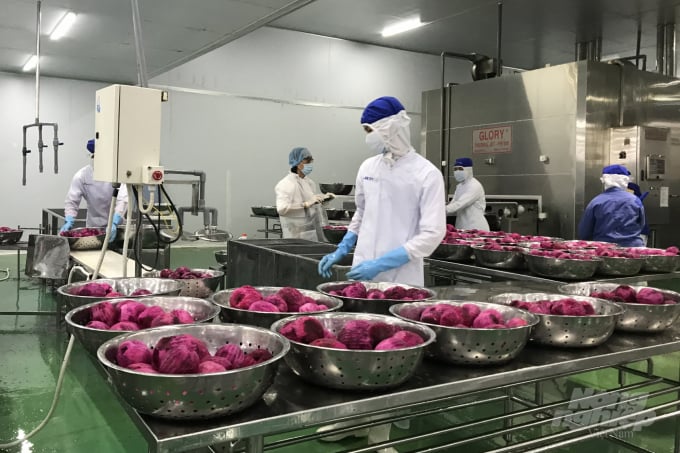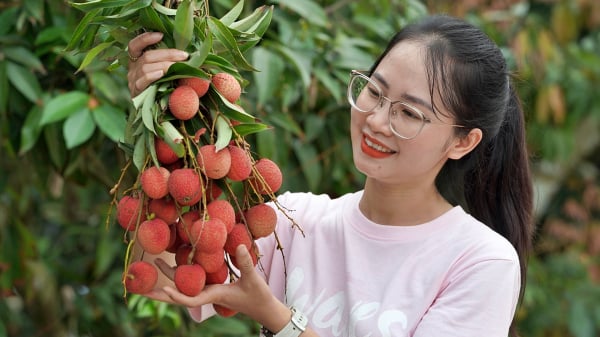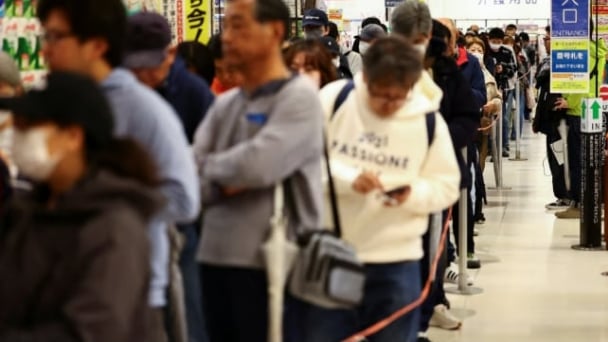June 11, 2025 | 13:16 GMT +7
June 11, 2025 | 13:16 GMT +7
Hotline: 0913.378.918
June 11, 2025 | 13:16 GMT +7
Hotline: 0913.378.918

China has been the largest Vietnamese fruit and vegetables market for many years. However, the dependence on the Chinese market is decreasing. Photo: Tran Trung.
China has been the largest Vietnamese fruit and vegetables market for many years. However, the dependence on the Chinese market is decreasing.
Fruit and vegetable exports in 2021 increased by 8.6% compared to 2020 when reaching US$ 3.55 billion. In which exports to China reached US$ 1.9 billion, an increase of only 3%. Thus, the growth in the past year was mainly due to other markets.
In addition, the vegetables and fruits exported to China continue to decrease significantly to the total value of Vietnamese fruit and vegetable exports.
In 2020, exports of vegetables and fruit to China accounted for 56.27% of total fruit and vegetable export value. By 2021, it's down to 53.71%. Meanwhile, a few years ago, this rate was 70%.
According to the Import-Export Department (Ministry of Industry and Trade), fruit and vegetable exports to Europe and America increased, while exports to Asia decreased.
In 2021, the export value of vegetables and fruits to the European and American markets will have high growth rates. Specifically, exports to Europe reached US$ 303 million, up 17.4% compared to 2020; to the Americas reached US$ 271 million, up 29.1% compared to 2020.
As a result, Europe's share in the total value of Vietnamese fruit and vegetable exports has increased from 7.9% in 2020 to 8.5% in 2021; America's market share increased from 6.4% to 7.6%.
In addition, Africa's share in the total value of Vietnam's fruit and vegetable exports also increased from 0.8% to 1.2%. Australia's market share remained unchanged at 2.6%.
Meanwhile, Asia's market share decreased from 82.2% to 80%, mainly China.
In January 2022, while fruit and vegetable exports to China decreased by 18.5% compared to January 2021, reaching only US$ 148.9 million, exports to the US market reached US$ 22.4 million, an increase of 69.8%.
Fruit and vegetable exports to the Korean market in January reached US$ 12.2 million, up 31.6% compared to January 2021. Exports to Japan reached US$ 11.8 million, up 12.2%. Exports to many other fastidious markets also increased strongly, such as Australia (up 45.7%), Netherlands (up 51.5%), Russia (up 33.9%).
Due to the impact of the Covid-19 epidemic, in 2021, the structure of Vietnam's fruit and vegetable exports has changed markedly. Specifically, while fruit and nut products decreased in export proportion, processed products increased.
The export value of processed fruits and vegetables in 2021 accounts for 25.3% of the total export value of vegetables and fruits, an increase of 1.5 percentage points compared to 2020.
In the Chinese market, where Vietnam mainly exported fresh fruits and vegetables, processed fruit and vegetable products increased enormously.

Diversifying export markets and increasing the proportion of processed products are the primary trend of Vietnam's fruit and vegetable industry in 2022. Photo: Tran Trung.
According to the General Department of Customs of China, in the first 11 months of 2021, Vietnam and the US are the two largest markets supplying processed fruits and vegetables to China, with an import value of 213 million USD from Vietnam, up to 34.9% over the same period in 2020.
This year, with the demand for processed fruits and vegetables continuing to increase globally due to the impact of Covid-19, Vietnam's fruit and vegetable industry will continue to shift firmly in product structure towards increasing processed products, reducing the export of fresh products.
The Import and Export Department (Ministry of Industry and Trade) said that the Covid-19 epidemic is not expected to negatively affect the global processed vegetable, fruit, and vegetable production industry. In contrast, the supply of processed fruits and vegetables increased as exports of fresh or frozen products decreased, forcing producers to shift to processing.
Although Vietnam's fruit and vegetable industry is making a positive transition to processing, compared with the development and integration requirements, Vietnam's processed fruit and vegetables still face many shortcomings and limitations that need to be resolved in the upcoming future.
Therefore, it is necessary to invest in post-harvest handling and preservation technology and develop logistics for transporting vegetables and fruits to help increase the export value of Vietnamese fruits and vegetables.
According to the European Statistical Office (Eurostat), the EU is the largest fruit and vegetable import market globally.
In the first ten months of 2021, the EU's imports of fruit and vegetables will reach US$ 100.3 billion, up 2.9% over the same period in 2020. The EU has a high demand for importing new highly nutritious fruit and vegetable products from the tropical region.
Notably, Vietnam is the only developing country in Asia-Pacific with a free trade agreement with the EU. After the EVFTA comes into effect, the tax rates for some Vietnamese vegetables and fruits entering the EU will be reduced to 0%. It is a substantial competitive advantage compared to other countries in the region.
According to the Import-Export Department, fruit is one of the potential products that Vietnam needs to exploit to take advantage of the EVFTA Agreement. Fruits having potential in the EU market in the upcoming future are fresh tamarind, cashew, jackfruit, litchi, plum, passion fruit, star fruit, dragon fruit, guava, mango, and mangosteen.
The US is also a potential market for Vietnamese fruits and vegetables. The diversity and openness in American culture always make consumers want to experience new products, bringing opportunities for specialty vegetables from the tropics of Vietnam.
According to the Vietnam Trade Office in the US, to increase fruit and vegetable exports to the US, domestic businesses should coordinate with importers and distributors in the US to study flexible payment methods and support risk sharing.
In addition, Vietnamese enterprises need to invest in cold storage to set up a distribution center for Vietnamese goods at a large import port on the West Coast, which can later be in the East or the South, on a large enough scale to serve a wide range of products. It will help reduce costs and create an initiative for businesses to bring products to the market.
Translated by Ha Phuc

(VAN) China's outbound shipments of rare earths in May jumped 23% on the month to their highest in a year, though Beijing's export curbs on some of the critical minerals halted some overseas sales.

(VAN) To sustain capital flow, administrative reform alone is not enough; what farmers truly need is an ecosystem where both government and businesses grow together in support.

(VAN) Vietnam and the United States are proactively working together, each in their own way, to ensure that every container of agricultural goods carries not just products, but also long-term trust and value.

(VAN) Stores have started selling rice from the government’s stockpile to feed demand for the staple.

(VAN) Omaha Steaks CEO says rebuilding cattle herds will take about a year to ease price pressures.

(VAN) Reciprocal tariffs and recent NOAA rulings are presenting substantial obstacles for Vietnamese tuna exporters in the U.S. market. As a result, the industry is actively seeking alternative export destinations.

(VAN) Although the U.S. holds a small share of Vietnam’s rubber exports, newly imposed reciprocal tariffs are expected to impact the sector. Vietnamese enterprises must optimize the use of significant markets and free trade agreements.